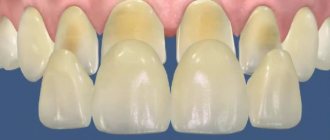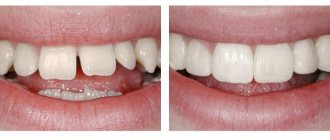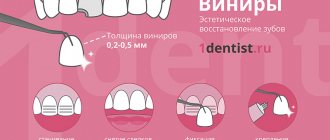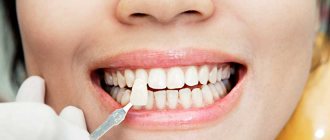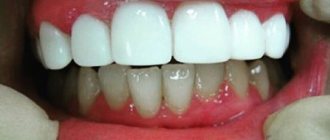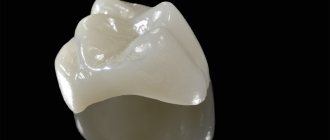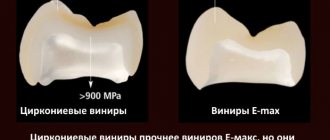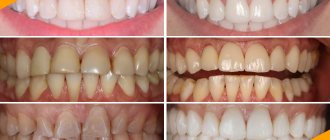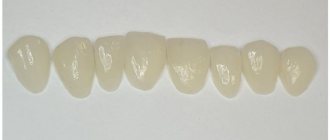Description of the procedure
In simpler terms, preparation is the grinding of teeth. This preparation stage in almost all cases is mandatory during installation. Its essence is to prepare the surface and level it. To do this, hard fabrics are ground to the desired size.
In order for the veneers to be securely fixed, it is important to achieve a sufficiently tight adhesion of the artificial material to the enamel coating. As a rule, natural teeth do not have a perfectly smooth surface, which is why such a procedure is necessary.
Preparation helps create the optimal correct shape, as a result of which the fastening will be more reliable, and the restoration of teeth will be as natural as possible.
Types of veneers that do not require tooth grinding
Composite veneers. Produced using the direct method. The technology of multilayer application of light-curing filling material is used, followed by illumination of each layer with a diode lamp.
This option has disadvantages:
- There is no guarantee of tightness;
- There is no natural color rendition and transparency;
- Fragility;
- Change in shade over time;
- If excess composite gets under the gum (it is quite difficult to remove), the veneer injures the mucous membrane and causes bleeding and inflammation of the gum tissue.
- Caries develops under veneers;
- Overlays increase the risk of developing periodontitis.
Componeers are overlay plates made of composite material, made in production conditions. Adaptation is made to the specific patient. This solution has fundamental differences from classic direct veneers:
- The latest generation nanohybrid material is used;
- Manufacturing takes place under high pressure conditions, with polymerization, in factory laboratories.
As a result, effective restoration of the front teeth occurs in one visit to the doctor.
The resulting very thin plates:
- They are characterized by increased strength;
- They easily adapt to the tooth, allowing you to adjust its shape and size.
As a result, it is ensured:
- Getting the desired shade;
- Complete sealing and absence of pores in the places of fixation and on the surface of the plate;
- Ideal aesthetics;
- High quality and functionality;
- Relatively low cost.
The technology for installing composite veneers is superior to the installation of traditional veneers in all respects.
Ceramic veneers are highly aesthetic and durable overlays that are made in one visit to the dentist, without tooth preparation.
Ceramic veneers, the so-called laminates, are the thinnest porcelain plates. Their thickness does not exceed 1.5 mm. They can be reinforced with a frame made of aluminum oxide or zirconium dioxide. But such a decision will entail thickening the plate and preparing the teeth.
Modern technologies make it possible to produce ultraneers and lumineers. To install them, it is enough to pre-treat the surface without preparation or anesthesia.
Indications and contraindications
Preparation is a necessary procedure used in many methods of orthopedic treatment in dentistry. Its main task is to grind off a small layer of enamel for further prosthetics.
Previously, this method of treating teeth was quite painful and time-consuming. Today, the process has been greatly simplified due to the use of ultra-precise instruments and modern painkillers.
Grinding of teeth during prosthetics is necessary. This is explained by the fact that microprostheses must fit well to natural teeth, but they do not have an ideal shape and therefore require processing.
In addition, the procedure is required to reduce the thickness of the enamel coating. Despite the fact that the overlay is quite thin, it still creates a certain volume. If the enamel is not thinned, the level of the prosthetic tooth will differ from the usual one, which is quite noticeable.
Preparation is also recommended in the presence of carious lesions. Under the lining, tooth decay occurs more quickly. Before installing a prosthesis, all damaged areas must be removed from the tooth.
In some cases, the procedure may not be necessary. The decision to carry out the preparatory procedure is made only by the dentist.
Situations when preparation can only do harm:
- there is severe wear of the dentition;
- a visual shift in the angle of the tooth is necessary;
- the tooth surface needs volume;
- there are uneven cutting edges;
- Lumineers are installed (they are thin and adhere well to special glue).
However, if the tooth unit is susceptible to carious lesions, then the preparation procedure is carried out regardless of the type of veneers used.
In what situations is it necessary to perform the preparation process?
Almost every time preparation is performed in treatment. Thanks to the removal of a small area of tissue, the orthopedic design is installed quite confidently and correctly fixed. When turning is performed, the surface of the tooth itself becomes rough, which allows you to confidently apply the material, without fear that it will not stick. Various uneven fragments of the tooth, as well as part of the enamel, are usually removed.
In order to identify in what situations it is necessary to perform the preparation process, you need to pay close attention to several indicators that are symptoms that this procedure must be performed without fail:
- The enamel has acquired an unnatural color.
- The tooth has acquired irregularities.
- The teeth are in a position that is unnatural for humans.
In order to correct these problems, it is necessary to remove part of the top layer. If the position of the tooth has an unnatural rotation, then a sufficiently large area must be removed. Thanks to the turning, there is sufficient space for the installation and firm fixation of the veneer. After grinding down for veneers, teeth do not look as aesthetically pleasing, but this is a mandatory step.
Marking of teeth before preparation for veneers
Grinding for veneers is a rather painful stage of treatment, although pain does not always occur in humans. In order to avoid painful sensations, various anesthetics are often used for pain relief.
Preparing your teeth is necessary in most situations. Of course, there are also moments when preparation is completely unnecessary:
- Small teeth.
- There is impressive wear.
- When there is a need to increase the size of the tooth.
The negative aspects of turning include:
- The teeth become more massive, which is noticeable even to the naked eye.
- Unpleasant sensations appear.
- Accumulations of food and harmful microbes may occur in the cervical region.
Preparation methods
Modern dentistry uses several methods of grinding teeth. These include:
- laser;
- ultrasonic;
- tunnel;
- chemical;
- air abrasive device.
Each of them is worth considering separately.
Laser preparation
The procedure occurs under the influence of a laser pulse. The rays help heat the fluid contained in the hard dental tissues. Under such influence, microscopic particles of enamel are destroyed. Advantages of this method:
- The procedure takes little time;
- does not pose health hazard
- does not cause pain ;
- does not require the use of additional tools or medications;
- minimally affects nerve endings;
- passes silently.
In addition, there is no need to pre-treat the oral cavity with an antiseptic solution, since laser beams have good disinfecting properties and help destroy any pathogenic microflora.
Ultrasound
This technique involves preparing the tooth using ultrasonic treatment with high-frequency vibration. Main properties:
- absolutely painless;
- soft tissues are not destroyed;
- prevents the formation of cracks on fasteners.
It also protects tooth tissue from excessive overheating.
Chemical method
This method of preparation involves using a special chemical composition under the veneer, which helps to soften the dentite layer and the enamel coating.
The main disadvantage is that it takes a long time (the procedure lasts up to 30 minutes).
Main advantages:
- there is no need to give anesthetic injection;
- cracks and chips do not form on the enamel surface
- teeth are protected from heat.
Tunnel preparation
A turbine unit is used to grind teeth. Diamond or metal burs can be used. This method allows you to:
- independently set the speed required for work;
- control the amount of thickness removed;
- accurately evaluate the final result.
On this topic
- Veneers
Pros and cons of installing veneers
- Maria Konstantinovna Tevs
- October 5, 2020
In addition to the positive aspects, the procedure also has negative aspects:
- overheating occurs , since old-generation installations are used;
- without anesthesia is accompanied by severe pain;
- Gum tissue injured during work
Air abrasive processing
This type of turning involves sandblasting hard fabrics. Powders are used as abrasive materials. This can be sodium bicarbonate, aluminum oxide and others.
The necessary substances are supplied to the dentin using a special tip, which leads to its destruction.
The main advantages of the technique:
- painlessness;
- no overheating of tissues;
- gentle influence.
The specialist decides together with the patient which method of preparation will be most optimal. In this case, all the nuances of prosthetics, the general condition of the teeth, and the technical capabilities of the dental clinic must be taken into account.
When is it necessary to prepare teeth for veneers?
In most cases, preparation is a mandatory stage of treatment. Removing a layer of tissue helps the orthopedic structure to fit tightly and securely on the tooth. During turning, a rough surface is created on which the dental material and structure are reliably glued. This removes irregularities and bumps in the enamel.
To understand in which cases preparation is necessary, you need to understand that veneers are installed on teeth to restore aesthetics and create a beautiful smile in the following cases:
- enamel discoloration,
- irregular tooth shape,
- minor violations of the correct position of the teeth.
To correct these disorders, it is necessary to remove a small layer of tissue. If there is a serious violation of the position of the tooth (retrusion, rotation), a significant amount of hard tissue is removed. With the help of turning, a place is created for the structure on the tooth; if it is absent, the veneer will interfere with the bite.
Grinding teeth for veneers may be accompanied by unpleasant or painful sensations. Therefore, doctors often provide pain relief with anesthetics.
Tooth preparation is necessary in the vast majority of situations. However, there are cases when you can do without preparation:
- small teeth size,
- abrasion of hard tissues,
- the need to increase the volume of the tooth.
The disadvantages of installing structures without turning include:
- thickening of the tooth, which may be noticeable to others,
- discomfort for the patient,
- accumulation of food debris and microorganisms in the cervical area.
Progress
As mentioned above, preparation for microprostheses requires preliminary grinding of the teeth. In order for the artificial material to adhere well to natural fabric, the enamel surface plays an important role. That is why, if possible, it is necessary to try to preserve it. However, this is not always possible and depends not only on carious lesions, but also on other changes in the tooth.
On this topic
- Veneers
The whole truth about dental veneers
- Maria Konstantinovna Tevs
- October 4, 2020
In any case, to install the veneer, sufficient space must be created. This will allow you to achieve more effective results. So, for example, if the tooth is heavily damaged by caries, then a larger amount of grinding tissue will be required, since the plate will need to be thicker in order to achieve maximum whiteness.
The preparation procedure consists of the following steps:
- Horizontal grooves are made on the outer surface. Their depth will depend on the size of the turning. Depth markings are carried out using diamond burs. The boundaries of the preparation capture not only the gingival height, but also the enamel layer. The space between the teeth is also treated.
- Remove the enamel coating. The thickness of the layer should not exceed more than one millimeter. This volume is the most suitable. In some cases, it is possible to increase the depth of grinding of the enamel. This process is especially inevitable in case of severe carious tooth damage. Additionally, the cutting edge is also processed.
- The surface of the teeth is polished.
On this topic
- Veneers
All about veneers without grinding
- Maria Konstantinovna Tevs
- September 30, 2020
Depending on what defect exists that requires correction, the preparation technique may differ slightly in each specific case. All actions are determined only by a specialist.
If rotated teeth are observed, then the first step is to reduce the protruding surface. Only after this should you start grinding the outside. To restore the shape in this case, a larger layer of enamel coating is removed from the protruding areas, and the lingual area, on the contrary, is closed as much as possible.
If there is an existing gap between the front teeth, the degree of treatment is determined only by the dentist. In this case, the size of the gap plays a major role. In most cases, in order to achieve the ideal shape, the treatment boundaries are expanded to the point where the adjacent teeth meet.
If an abnormal location of the dental unit is diagnosed, the volume of grinding will be significantly increased. Initially, the outer protrusion is ground down until it reaches the level of the arc of the tooth, only after that the entire surface and cutting edge are processed. To avoid difficulties during the formation of the palatal area, the entire space is ground down to the gum tissue.
On this topic
- Veneers
The whole truth about ceramic onlays for teeth
- Maria Konstantinovna Tevs
- September 30, 2020
In addition, the stages of the procedure will also depend on the material from which the veneers are made.
Thus, ceramic linings are the most popular. Their service life reaches up to 15 years. They are characterized by high structural strength and are not stained by food coloring. Since there are so many options for preparation, it is important to choose a good specialist.
If the procedure is performed incorrectly, even the most expensive artificial materials will look unnatural and ugly. Since in this case the plates have a thickness of about two millimeters, and grinding affects the gum tissue or ends at its level, it would be better to use the indirect method, since it is thanks to it that the greatest aesthetics can be achieved.
Preparing a tooth for a composite also has its own characteristics. In this case, the plates are placed on the tooth itself, so the outer surface is practically not subjected to grinding. Only certain areas are subject to allocation.
At the end of the procedure, an impression is made. For this, polyester, silicone or other suitable material is used. Composite overlays are immediately installed.
